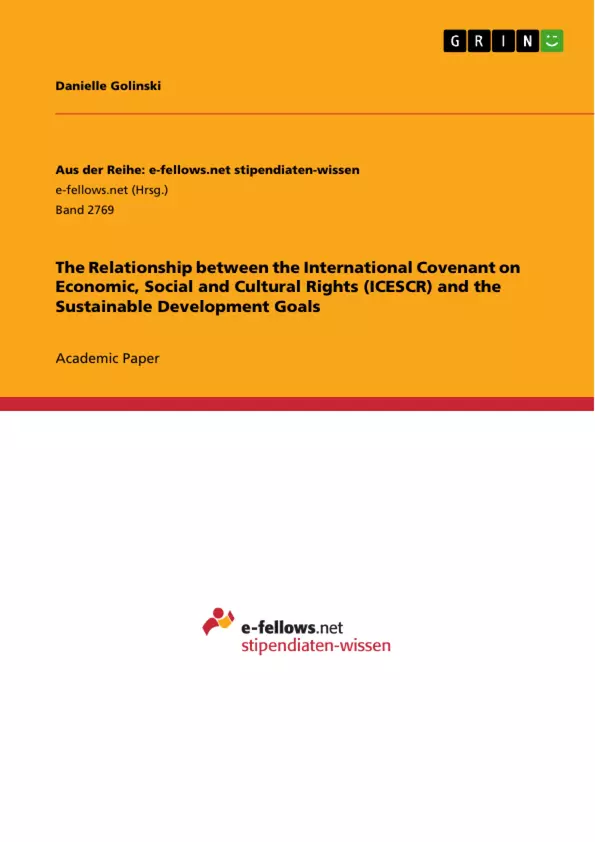Facing global challenges like armed conflicts, climate change and scarcity of resources, the UN as a platform for the international cooperation and global peace still is of majour significance. During the last decades, the focus of its work has shifted to legally non-binding agendas, most recently the Sustainable Development Goals (SDG), which stand in the focus of their time and address sustainability. The greatest weakness of the work of the United Nations is its poor enforcement due to legally non-binding documents. This is also a weak point of the Sustainable Development Goals. As the agenda is contained within a legally non-binding UN Resolution, it is at the specific state’s discretion whether and to what extent the SDG are implemented. In these terms, the Goals show a deficit compared to binding human rights treaties within the UN human rights system. This system is based upon the Universal Declaration of Human Rights, the International Covenant on Civil and Political Rights (ICCPR) and the International Covenant on Economic, Social, and Cultural Rights (ICESCR), which is together known as the Bill of Rights and celebrated its 50th anniversary in 2016. The question arises, whether and how existent legally binding UN sources could support the implementation of the non-binding Sustainable Development Goals. As the Goals also address issues of individual’s economic, social and cultural life, the ICESCR could be a suitable guideline for implementation, assuming that the SDG focus on the same content as the Covenant, which are economic, social and cultural rights. In turn, the question arises whether the Sustainable Development Goals as a contemporary and modern work of the United Nations, could impact the long-established covenant.
In order to examine these questions, this thesis will analyse the interelationships between the ICESCR and the new Sustainable Development Goals.
Table of Contents
- Introduction
- The International Covenant on Economic, Social and Cultural Rights
- History and Development
- Brief Overview
- What are Economic, Social and Cultural rights?
- The Sustainable Development Goals
- History and Development
- Brief Overview
- What is Sustainable Development?
- Comparison of the Content in Respect of Human Rights
- Decent Work and Employment
- Adequate Living Standard and Social Welfare
- Family protection
- Health
- Education
- Cultural Participation and Scientific Progress
- Conclusion - Do the Sustainable Development Goals Contain Economic, Social and Cultural Rights?
- The Covenant and the Implementation of the Sustainable Development Goals
- The Indivisibility and Coherence of the UN Human Rights System and the Position of the SDG
- Indicators and Standards for the Implementation of Human Rights in the ICESCR
- Suitable Indicators and Standards for the Implementation of the Sustainable Development Goals
- Conclusion
- Impact of the Sustainable Development Goals on the ICESCR
Objectives and Key Themes
This thesis aims to examine the relationship between the International Covenant on Economic, Social and Cultural Rights (ICESCR) and the Sustainable Development Goals (SDG). It explores whether and how the legally binding ICESCR can support the implementation of the non-binding SDG, focusing on the content of both documents regarding economic, social and cultural rights. Furthermore, the thesis investigates whether the contemporary SDG could impact the long-established ICESCR.
- The history and development of the ICESCR and the SDG
- The content of the ICESCR and the SDG in terms of economic, social and cultural rights
- The potential for the ICESCR to support the implementation of the SDG
- The potential impact of the SDG on the ICESCR
- The role of the UN human rights system in the context of the ICESCR and the SDG
Chapter Summaries
The first chapter introduces the topic and highlights the importance of examining the relationship between the ICESCR and the SDG. The second chapter provides a detailed overview of the ICESCR, tracing its history, development, and key provisions. The third chapter explores the history, development, and core principles of the SDG. The fourth chapter offers a comparative analysis of the content of the ICESCR and the SDG, focusing on specific areas such as decent work and employment, adequate living standard, health, and education. The fifth chapter examines the potential for the ICESCR to support the implementation of the SDG, considering aspects like the indivisibility of human rights, indicators and standards for implementation.
Keywords
This thesis explores the relationship between the International Covenant on Economic, Social and Cultural Rights (ICESCR), sustainable development goals (SDG), human rights, economic, social and cultural rights, UN human rights system, legally binding, non-binding, implementation, indicators, standards.
- Quote paper
- Danielle Golinski (Author), 2017, The Relationship between the International Covenant on Economic, Social and Cultural Rights (ICESCR) and the Sustainable Development Goals, Munich, GRIN Verlag, https://www.hausarbeiten.de/document/429642


